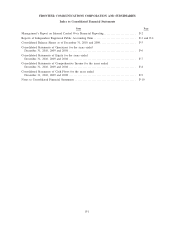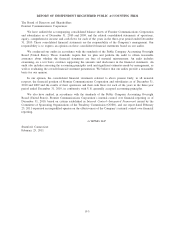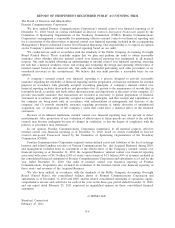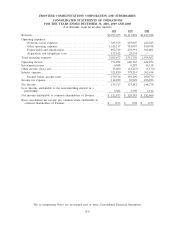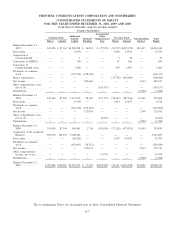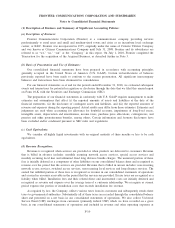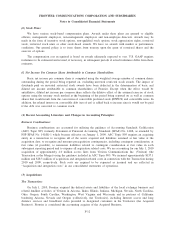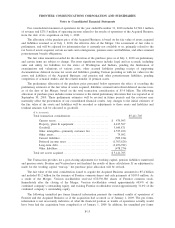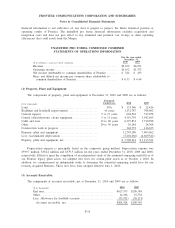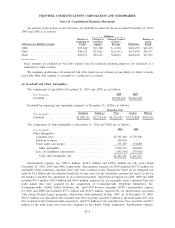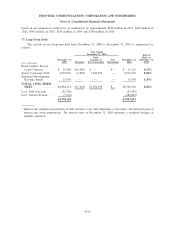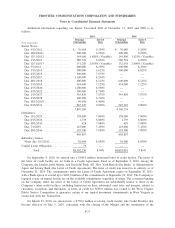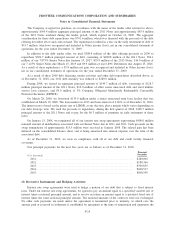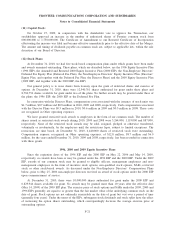Frontier Communications 2010 Annual Report Download - page 70
Download and view the complete annual report
Please find page 70 of the 2010 Frontier Communications annual report below. You can navigate through the pages in the report by either clicking on the pages listed below, or by using the keyword search tool below to find specific information within the annual report.$73.8 million, $35.5 million and $37.1 million for the years ended December 31, 2010, 2009 and 2008,
respectively.
(e) Property, Plant and Equipment:
Property, plant and equipment are stated at original cost or fair market value for our acquired properties,
including capitalized interest. Maintenance and repairs are charged to operating expenses as incurred. The gross
book value of routine property, plant and equipment retired is charged against accumulated depreciation.
(f) Goodwill and Other Intangibles:
Intangibles represent the excess of purchase price over the fair value of identifiable tangible net assets
acquired. We undertake studies to determine the fair values of assets and liabilities acquired and allocate
purchase prices to assets and liabilities, including property, plant and equipment, goodwill and other
identifiable intangibles. We annually (during the fourth quarter) or more frequently, if appropriate, examine the
carrying value of our goodwill and trade name to determine whether there are any impairment losses. We test
for goodwill impairment at the “operating segment” level, as that term is defined in U.S. GAAP. As of July 1,
2010 and as a result of the completion of the Transaction, the Company has five operating segments. Our
operating segments are aggregated into one reportable segment.
The Company amortizes intangible assets with estimated useful lives over those lives and reviews such
intangible assets to assess any impairment and whether factors exist that would necessitate a change in useful
life and a different amortization period. In addition, we periodically reassess the useful lives of our intangible
assets to determine whether any changes are required.
(g) Impairment of Long-Lived Assets and Long-Lived Assets to Be Disposed Of:
We review long-lived assets to be held and used and long-lived assets to be disposed of, including
customer lists, for impairment whenever events or changes in circumstances indicate that the carrying amount
of such assets may not be recoverable. Recoverability of assets to be held and used is measured by comparing
the carrying amount of the asset to the future undiscounted net cash flows expected to be generated by the
asset. Recoverability of assets held for sale is measured by comparing the carrying amount of the assets to their
estimated fair market value. If any assets are considered to be impaired, the impairment is measured by the
amount by which the carrying amount of the assets exceeds the estimated fair value. Also, we periodically
reassess the useful lives of our tangible and intangible assets to determine whether any changes are required.
(h) Derivative Instruments and Hedging Activities:
We account for derivative instruments and hedging activities in accordance with U.S. GAAP which
requires that all derivative instruments, such as interest rate swaps, be recognized in the financial statements
and measured at fair value regardless of the purpose or intent of holding them.
(i) Investments:
Investments in entities that we do not control, but where we have the ability to exercise significant
influence over operating and financial policies, are accounted for using the equity method of accounting.
(j) Income Taxes and Deferred Income Taxes:
We file a consolidated federal income tax return. We utilize the asset and liability method of accounting
for income taxes. Under the asset and liability method, deferred income taxes are recorded for the tax effect of
temporary differences between the financial statement basis and the tax basis of assets and liabilities using tax
rates expected to be in effect when the temporary differences are expected to reverse.
F-11
FRONTIER COMMUNICATIONS CORPORATION AND SUBSIDIARIES
Notes to Consolidated Financial Statements


